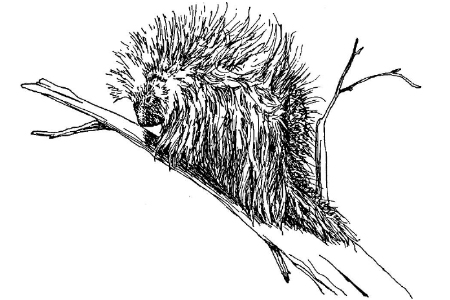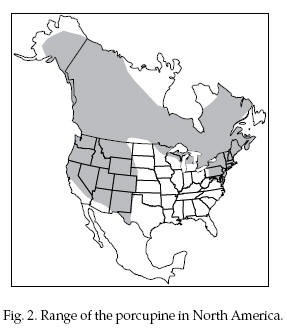|
|
|
|
 |
RODENTS: Porcupines |
|
|

Fig. 1. Porcupine,
Erethizon dorsatum
Damage
Prevention and Control Methods
- Exclusion
- Fences (small
areas). Tree trunk guards.
- Cultural Methods
- Encourage
closed-canopy forest stands.
- Repellents
- None are
registered.
- Some wood
preservatives may incidentally repel porcupines.
- Toxicants
- None are
registered.
- Fumigants
- None are
registered.
- Trapping
- Steel leghold trap
(No. 2 or 3). Body-gripping (Conibear®) trap (No.
220 or 330). Box trap.
- Shooting
- Day shooting and
spotlighting are effective where legal.
- Other Methods
- Encourage natural
predators.
Identification
Porcupines (Erethizon
dorsatum), sometimes called “porkies” or “quill pigs,”
(Fig. 1) are heavy-bodied, short-legged, slow, and
awkward rodents, with a waddling gait. Adults are
typically 25 to 30 inches (64 to 76 cm) long and weigh
10 to 30 pounds (4.5 to 13.5 kg). They rely on their
sharp, barbed quills (up to 30,000 per individual) for
defense.
 Range
and Habitat Range
and Habitat
The porcupine is a common
resident of the coniferous forests of western and
northern North America (Fig. 2) It wanders widely and is
found from cottonwood stands along prairie river bottoms
and deserts to alpine tundra.
Food Habits
Porcupines eat herbaceous
plants, inner tree bark, twigs, and leaves, with an
apparent preference for ponderosa pine, aspen, willow,
and cottonwood. Trees with thin, smooth bark are
preferred over those with thick, rough bark. Porcupine
feeding is frequently evident and has considerable
impact on the cottonwood stands of western river
bottoms.
General Biology, Reproduction, and Behavior
Porcupines breed in
autumn, and after a 7-month gestation period usually
produce 1 offspring in spring. Although the young are
capable of eating vegetation within a week after birth,
they generally stay with the female through the summer.
Juvenile survival rates are high.
Predators of porcupines
include coyotes, bobcats, mountain lions, black bears,
fishers, martens, great horned owls, and others. Coyote
scats (feces) containing large numbers of quills are not
unusual. How the quills are maneuvered through the
coyote’s gastrointestinal tract is a mystery.
Porcupines are active
year-round and are primarily nocturnal, often resting in
trees during the day. They favor caves, rock slides, and
thick timber downfalls for shelter.
Damage and Damage Identification
 Clipped
twigs on fresh snow, tracks, and gnawings on trees are
useful means of damage identification (Fig. 3). Trees
are often deformed from partial girdling. Porcupines
clip twigs and branches that fall to the ground or onto
snow and often provide food for deer and other mammals.
The considerable secondary effects of their feeding come
from exposing the tree sapwood to attack by disease,
insects, and birds. This exposure is important to many
species of wildlife because diseased or hollow trees
provide shelter and nest sites. Clipped
twigs on fresh snow, tracks, and gnawings on trees are
useful means of damage identification (Fig. 3). Trees
are often deformed from partial girdling. Porcupines
clip twigs and branches that fall to the ground or onto
snow and often provide food for deer and other mammals.
The considerable secondary effects of their feeding come
from exposing the tree sapwood to attack by disease,
insects, and birds. This exposure is important to many
species of wildlife because diseased or hollow trees
provide shelter and nest sites.
Porcupines occasionally
will cause considerable losses by damaging fruits, sweet
corn, alfalfa, and small grains. They chew on hand tools
and other wood objects while seeking salt. They destroy
siding on cabins when seeking plywood resins.
Porcupines offer a
considerable threat to dogs, which never seem to learn
to avoid them. Domestic stock occasionally will nuzzle a
porcupine and may be fatally injured if quills are not
removed promptly.
Legal Status
Porcupines are considered
nongame animals and are not protected.
Damage Prevention and Control Methods
Exclusion
Fencing small tree plantings, orchards, and gardens
is effective in reducing porcupine damage. Electric
fences are effective when the smooth electric wire is
placed 1 1/2 inches (3.8 cm) above 18-inch-high (46-cm)
poultry wire. A 4- to 6-inch (10-to 15-cm) electric
fence can be enhanced by painting molasses on the wire.
Porcupines will climb fences, but an overhanging wire
strip around the top of the fence at a 65o angle to the
upright wire will discourage them.
Completely enclose small
trees with wire baskets or encircle the trunks of fruit
and ornamental trees with 30-inch (70-cm) bands of
aluminum flashing to reduce damage.
Cultural Methods
Thinned forest stands are vulnerable to porcupine
damage because lower vegetation can thrive. Porcupine
populations are usually lower in closed canopy stands
where understory vegetation is scant.
Repellents
Thiram is registered as a squirrel and rabbit repellent
and may incidentally repel porcupines. This material is
sprayed or painted on the plants subject to damage. It
must be renewed occasionally to remain effective. Common
wood preservatives may repel porcupines when applied to
exterior plywoods. Avoid using wood preservatives that
are metal-salt solutions. These will attract porcupines.
Toxicants
No toxicants can be legally used to control
porcupines.
Trapping
Steel leghold traps of size No. 2 or 3 can be used
to catch porcupines where legal. Cubby sets with salt
baits, trail sets in front of dens, and coyote urine
scent post sets near dens and damage activity are
effective. Scent post and trail sets must be checked
daily to release nontarget animals that might be caught.
Leghold traps should be bedded, firmly placed and
leveled, and offset slightly to the side of the trail.
The trapped porcupine can be shot or killed by a sharp
blow to the head.
The No. 220 or 330
Conibear® body-gripping trap can be baited with a
salt-soaked material or placed in den entrances to catch
and kill porcupines. Care must be taken to avoid taking
nontarget animals, since salt attracts many animals. The
Conibear® trap does not allow the release of accidental
catches. Some states do not allow the use of No. 330
Conibear® traps for ground sets.
Porcupines are rather easy
to livetrap with large commercial cage traps (32 x 10 x
12 inches [81 x 25 x 30.5 cm]) or homemade box traps.
Place the live trap in the vicinity of damage and bait
with a salt-soaked cloth, sponge, or piece of wood. Live
traps also can be set at den entrances. Move the
porcupine 25 miles (40 km) or more to ensure that it
does not return. Since most areas of suitable habitat
carry large porcupine populations, relocation of the
porcupine often is neither helpful nor humane since the
introduced animal may have a poor chance of survival.
Shooting
Persistent hunting and shooting of porcupines can be
effective in reducing the population in areas that
require protection. Night hunting, where legal, is
effective. During winter months, porcupines are active
and can be tracked in the snow and shot with a
.22-caliber rifle or pistol. Porcupines often congregate
around good denning sites and extensively girdle trees
in the area. In such places large numbers may be taken
by shooting.
Other Considerations
Porcupines are mobile and continually reinvade
control areas. Complete control is not desirable since
it would require complete removal of porcupines. Try to
limit lethal porcupine control to individual animals
causing damage by fencing and management of the plant
species. In areas of high porcupine populations, plant
ornamentals that are not preferred foods. Intensive
predator control may encourage porcupine population
increases.
Economics of Damage and Control
Economic losses can be
considerable from porcupines feeding on forest
plantings, ornamentals, and orchards as well as on
leather and other human implements. Porcupines generally
are tolerated except when commercial timber, high-value
ornamental plantings, orchards, or nursery plants are
damaged by girdling, basal gnawing, or branch clipping.
On occasion, porcupines thin dense, crowded forest
stands. Often tree diameter growth is reduced. Their
preference for mistletoe as a food is an asset.
The porcupine is acclaimed
as a beautiful creature of nature. It is an interesting
animal that has an important place in the environment.
It is edible and has been used by humans as an emergency
food. The quills are used for decorations, especially by
Native Americans. The hair, currently used for
fly-fishing lures, commands many dollars per ounce.
Porcupines are not wary and can be readily observed and
photographed by nature lovers. Porcupines may need to be
controlled but should not be totally eradicated.
Acknowledgments
Some of the information
for this chapter was taken from a chapter by Major L.
Boddicker in the 1980 edition of Prevention and Control
of Wildlife Damage.
Figure 1 by Emily Oseas
Routman.
Figure 2 adapted from Burt
and Grossenheider (1976) by Jill Sack Johnson.
Figure 3 adapted from
Murie (1954) by Renee Lanik, University of
Nebraska-Lincoln.
For Additional Information
Burt, W. H., and R. P.
Grossenheider. 1976. A field guide to the mammals, 3d
ed. Houghton Mifflin Co., Boston. 289 pp.
Clark, J. P. 1986.
Vertebrate pest control handbook. California Dep. Food
and Agric. Sacramento. 615 pp.
Dodge, W. E. 1982.
Porcupine. Pages 355-366 in J. A. Chapman and G. A.
Feldhamer, eds. Wild mammals of North America: biology,
management, and economics. The Johns Hopkins Univ.
Press. Baltimore.
Marsh, R. E., and W. E.
Howard. 1977. Vertebrate control manual. Pest Control
45:28-31.
Murie, O. J. 1954. A field
guide to animal tracks. Houghton Mifflin Co., Boston.
375 pp.
Roze, V. 1989. The North
American porcupine. Smithsonian Press, Washington, DC.
261 pp.
Spencer, D. A. 1948. An
electric fence for use in checking porcupine and other
mammalian crop depredations. J. Wildl. Manage.
12:110-111.
Woods, C. A. 1978.
Erethizon dorsatum. Mammal. Sp. 29:1-6.
Editors
Scott E. Hygnstrom, Robert
M. Timm, Gary E. Larson
PREVENTION AND CONTROL OF
WILDLIFE DAMAGE — 1994
Cooperative Extension
Division Institute of Agriculture and Natural Resources
University of Nebraska -Lincoln
United States Department
of Agriculture Animal and Plant Health Inspection
Service Animal Damage Control
Great Plains Agricultural
Council Wildlife Committee
10/18/2005
Special
thanks to:
Clemson University
|